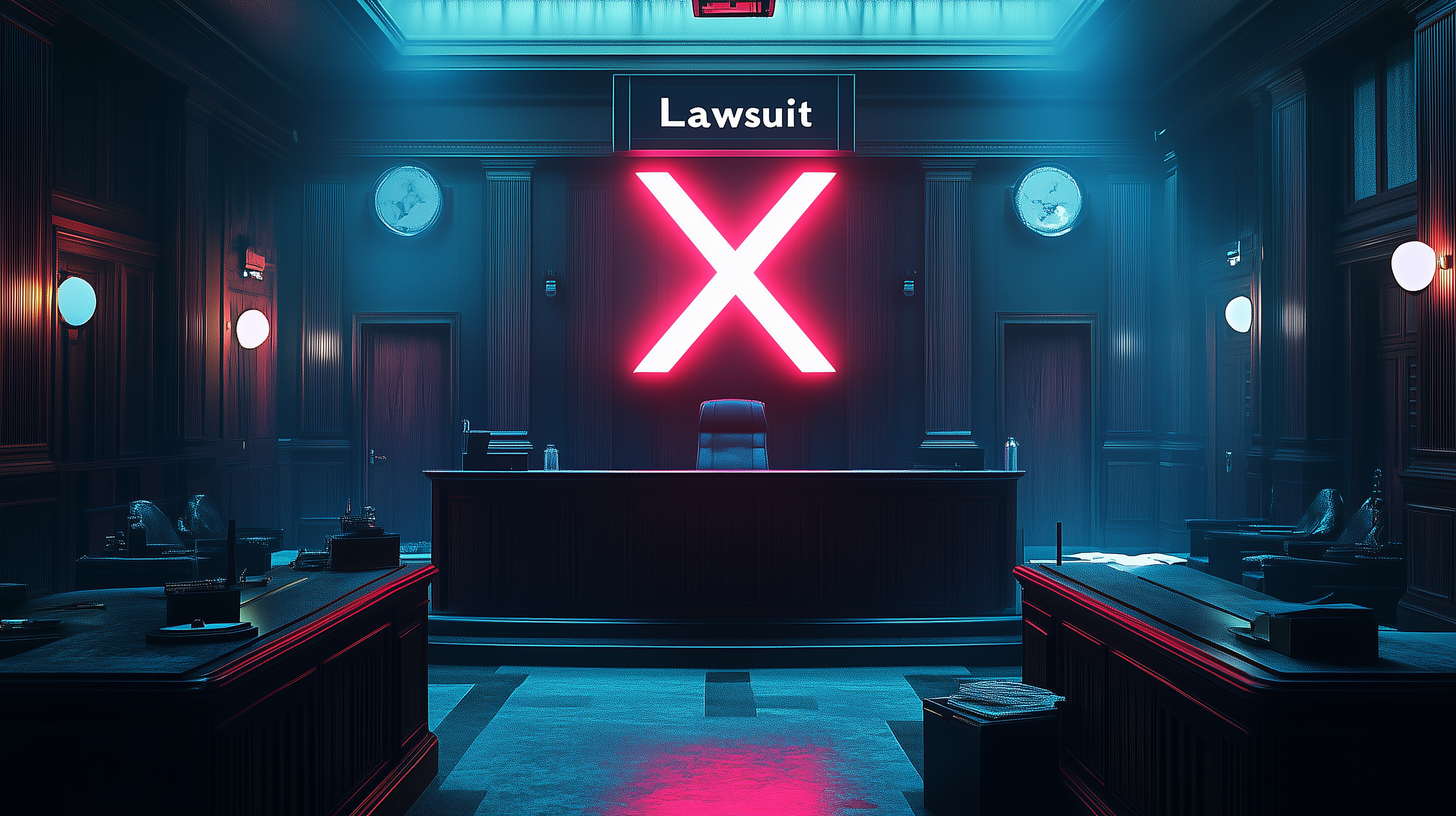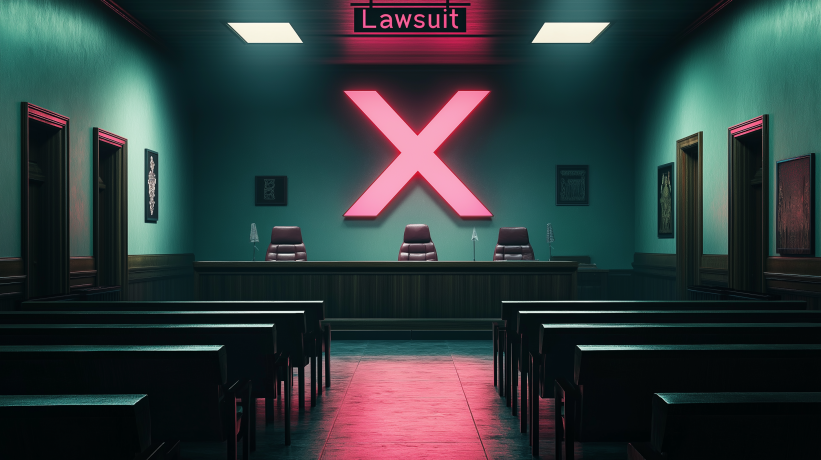
A federal judge has allowed X Corp's defamation lawsuit against Media Matters to proceed, finding plausible claims of algorithmic manipulation and business interference. This ruling sets the stage for a high-stakes legal battle that could reshape the landscape of social media criticism and platform accountability.
by LawInc Staff
August 30, 2024
In a significant legal development, a federal judge in Texas has cleared the way for X Corp., formerly Twitter and now owned by Elon Musk, to take its defamation and tortious interference case against Media Matters for America to trial. The judge denied Media Matters’ motion to dismiss, finding that X’s complaint alleges sufficient facts at this stage to state plausible claims against the defendants.
This guide dives into the details of X’s allegations, the judge’s reasoning in allowing the case to proceed, and the key legal issues that will be in play as this high-stakes battle between Musk’s social media giant and the media watchdog group unfolds.
From the complaint’s specific accusations about Media Matters’ alleged plot to smear X as overrun with hate speech to the court’s analysis of personal jurisdiction, venue, and the sufficiency of the claims, learn all you need to know about this complex case — even if you don’t have a legal background.
1. Understand X’s Core Allegations Against Media Matters
-
- Manipulating X’s Platform Algorithms: X claims Media Matters created inauthentic accounts that followed a specific mix of fringe and advertiser accounts to produce an unrepresentative feed.
- Generating Misleading Screenshots: Using this manipulated feed, Media Matters allegedly generated intentionally misleading screenshots showing ads next to inflammatory content.
- Falsely Portraying X as Rife with Hate Speech: X argues Media Matters used these manufactured screenshots to falsely claim that X knowingly allows hate speech to flourish and monetizes it.
- Driving Away Advertisers Through Deception: Media Matters allegedly leveraged this deceptive narrative to pressure major brands to pull their ads from X.
- Intentionally Harming X’s Business Relationships: X claims this was all part of Media Matters’ deliberate strategy to harm its ad revenue and relationships with brands and users.
Real-World Context:
-
- Media Matters has long been critical of what it perceives as right-wing misinformation on social media platforms like X (formerly Twitter).
- As the most prominent platform for free speech online, X is a frequent Media Matters target, especially since Elon Musk’s takeover.
- Many major brands are highly sensitive to their ads appearing next to controversial content, making them susceptible to these kinds of pressure campaigns.
Key Takeaways:
-
- X’s lawsuit hinges on proving Media Matters deliberately misrepresented the authentic X user experience to advance a smear campaign.
- The core accusation is that Media Matters manufactured “evidence” of ads next to hate speech, not that this occurs organically on X at any meaningful scale.
- X will need to back up its claims of tangible harm to its business and reputation through lost advertisers and damaged goodwill.
Legal Analysis:
-
- To prove defamation, X will have to show Media Matters made provably false statements of fact (not just opinion), with actual malice.
- The tortious interference claims require showing Media Matters intentionally and improperly interfered with X’s business relationships, causing concrete harm.
- Media Matters will likely argue its critiques of X are protected opinion and that it was engaging in legitimate watchdog journalism and commentary.
2. Break Down the Judge’s Key Rulings on Jurisdiction, Venue, and the Motion to Dismiss
-
- Personal Jurisdiction Exists: The judge found Media Matters’ articles and conduct were purposefully directed at harming X’s relationships with Texas-based advertisers like AT&T and Oracle.
- Venue is Proper in Texas: Media Matters allegedly aimed its actions at business relationships within the Northern District of Texas, resulting in a significant portion of the events underlying the claims occurring in this region.
- X Stated Valid Legal Claims: Taking X’s factual allegations as true at this stage, the judge ruled that X alleged enough to proceed on all three of its legal causes of action.
- Case Survives Motion to Dismiss: Though Media Matters argues X’s claims are baseless, the court must accept X’s well-pleaded allegations as true for now and let the claims move forward.
- Factual Disputes Will Be Decided Later: The court did not resolve any clashing facts between the parties’ accounts at this stage; that’s for summary judgment or trial.
Real-World Context:
-
- Faced with a well-funded plaintiff like X/Musk, many defendants try to kick cases on technical jurisdictional grounds before even reaching the merits.
- Motions to dismiss for failure to state a claim are common defense tactics to test the basic legal sufficiency of a plaintiff’s case at the outset.
- Courts are often hesitant to dismiss cases at the pleadings stage unless the claims are really flimsy, preferring to let parties gather evidence first.
Key Takeaways:
-
- X survived the first round of legal challenges to its lawsuit, but still has a long way to go to actually prove its claims.
- The Texas judge found enough connection between Media Matters’ conduct and harm to Texas-based companies to assert jurisdiction and venue.
- The court simply ruled X alleged the basic elements of its claims, not that it had proven them or would ultimately prevail.
Legal Analysis:
-
- Asserting personal jurisdiction over an out-of-state defendant requires showing they purposefully directed their tortious conduct at the forum state.
- Venue is appropriate in the district where a significant part of the events underlying the claims took place, regardless of whether more substantial activities occurred in other locations.
- Courts are very hesitant to dismiss cases on bare pleadings without giving the plaintiff a chance to develop evidence supporting their claims.
3. Dive Deeper into Each of X’s Legal Claims and What It Must Prove
-
- Defamation: X claims Media Matters made verifiably false statements of fact that damaged its reputation, and did so with actual malice, meaning knowingly or recklessly.
- Tortious Interference with Existing Contracts: X alleges Media Matters intentionally interfered with its advertiser contracts, causing brands to pull ad campaigns.
- Tortious Interference with Prospective Business: Even if advertisers hadn’t signed contracts yet, X claims Media Matters interfered with its potential future ad deals too.
- Damages: It’s not enough to prove wrongful acts; X will need to provide concrete evidence of harm like lost ad revenue and damage to its goodwill and reputation.
Real-World Context:
-
- Defamation cases by public figures face a very high bar, needing to prove false facts and actual malice, not just unflattering opinions.
- Tortious interference requires showing the defendant improperly meddled in the plaintiff’s business relationships, not just engaged in fair competition.
- Courts want to see hard numbers and evidence of economic harm, not just allegations that the plaintiff’s feelings or reputation were hurt.
Key Takeaways:
-
- Legally, defamation requires proving false statements of fact made with actual malice, while tortious interference involves improperly harming business relationships.
- Factually, X will need to back up its claims with evidence of Media Matters’ deceptive scheme and how it directly harmed X’s finances and advertiser relationships.
- Expect both sides to proffer competing evidence, like Media Matters touting any organic instances of hate speech on X and X showing how rarely that content actually gets amplified.
Legal Analysis:
-
- Media Matters will likely argue that its articles contained protected opinion based on disclosed facts, not outright falsehoods.
- X will counter that the “facts” Media Matters relied on were themselves deliberately fabricated, and that it acted with reckless disregard for the truth.
- The line between tough watchdog journalism and tortious smear campaigns is often contentious — much will depend on the specific evidence uncovered in discovery.
4. Potential Implications of the Case on Social Media and Legal Frameworks
-
- Potential Chilling Effect on Media Watchdogs: If X prevails, critics may become more hesitant to call out questionable content on social platforms for fear of lawsuits.
- Implications for Content Moderation Practices: The case could influence how social networks handle controversial speech and police inauthentic activity aimed at gaming algorithms.
- Fact vs. Opinion in an Age of Algorithmically-Curated Feeds: The litigation may help define the line between protected opinion and actionable misinformation in the context of social media feeds shaped by opaque algorithms.
- Balancing Free Speech vs. Platform Health: X argues it’s fighting Media Matters’ alleged smear job to protect free expression on its platform, but some see Musk’s approach as too hands-off to toxic content.
- Battle Over Social Media’s Reputational Impact: The case is part of a broader reckoning with social platforms’ power to shape perceptions and sway offline behavior, from advertising choices to election outcomes.
Real-World Context:
-
- High-stakes legal battles between media critics and the outlets they scrutinize have often hinged on whether their commentary constitutes protected opinion or defamation.
- Social platforms have long struggled to draw clear lines between free speech and harmful misinformation, with each controversy stoking debate over their content moderation policies.
- As social media’s influence over public discourse has grown, so have concerns about its potential to rapidly spread false narratives and shape real-world behavior.
Key Takeaways:
-
- The X v. Media Matters case sits at the intersection of several thorny debates around social media’s societal impact and the boundaries of acceptable online speech.
- Its outcome could affect the appetite of watchdogs to aggressively call out troubling content on internet platforms, and how those platforms respond to such critiques.
- With Musk positioning himself as a “free speech absolutist,” onlookers will watch to see if X can preserve an open dialogue without devolving into a hotbed of toxicity and abuse.
Legal Analysis:
-
- The case may help refine longstanding legal principles around defamation and tortious interference to better fit the realities of a social media-saturated world.
- Courts will likely consider the unique dynamics of algorithmically-shaped online discourse when weighing whether Media Matters’ posts were misleading or X’s business was unjustly harmed.
- While the First Amendment sets a high bar for punishing speech about public figures and issues, X may argue that deliberately gaming its algorithms amounts to a tortious abuse of free speech principles.
5. Consider the Case’s Political Backdrop and Larger Societal Stakes
-
- Musk’s Divisive Stewardship of X/Twitter: The controversial billionaire’s “free speech” approach has drawn cheers from some and fears from others about loosened content guardrails.
- Culture War over Tech’s Political Impact: The case feeds into simmering left-right battles over whether social platforms are inappropriately stifling or amplifying certain views.
- Debate over Journalism Ethics and Tactics: Some see Media Matters’ posts as important media criticism, others as misleading propaganda intended to harm a disfavored platform.
- Questions of Platform Transparency and Accountability: The case highlights the opaque, black-box nature of social networks’ content ranking and moderation systems, and attendant risks of gaming and manipulation.
- Tension Between Profits and Policing Content: X wants to assure skittish advertisers it’s brand-safe, while avoiding perceptions of heavy-handed speech restrictions.
Real-World Context:
-
- Musk has called himself a “free speech absolutist” and pledged to make X a haven for open discourse, alarming some critics who worry that could enable hate speech and misinformation.
- In recent years, right-leaning politicians have accused left-leaning watchdogs and tech platforms of censoring conservative views, while those on the left warn of social media’s potential to radicalize users and undermine democracy.
- The case comes amidst growing regulatory pressure on tech giants worldwide, with policymakers demanding more insight into and checks on their opaque algorithms and content moderation systems.
Key Takeaways:
-
- The X v. Media Matters fight is as much a political and cultural clash as a legal one, channeling broader societal anxieties around social media’s ever-expanding influence.
- With Musk’s takeover of the platform sparking heated debate over content rules, the case will be closely watched for clues about X’s evolving approach to policing user speech.
- Regardless of the suit’s outcome, the underlying tensions it reflects around social platforms’ power, transparency and responsibility are likely to endure and even intensify.
Legal Analysis:
-
- While courts are generally wary of penalizing speech on matters of public concern, the law does recognize some limits when that speech causes concrete, unjustified harm.
- X may argue that whatever its political bent, Media Matters crossed a bright legal line by ginning up a deceptive pressure campaign based on fabrications rather than facts.
- But Media Matters is likely to cast its posts as legitimate opinion, arguing that any aggressive rhetoric or alleged mistakes don’t rise to the level of actionable defamation or tortious conduct.
Summary

The X v. Media Matters case is shaping up to be a high-stakes legal battle over the boundaries between media criticism, political activism and tortious smear tactics in the social media age.
The X Corp. v. Media Matters lawsuit is more than a run-of-the-mill defamation spat — it’s a politically-charged battle over the role and power of social media platforms, media watchdogs, and online speech itself in today’s information ecosystem.
With X alleging a deliberate campaign to smear its reputation and sabotage its business through algorithmic manipulation, and Media Matters defending its posts as legitimate opinion and media criticism, the case channels America’s polarized digital discourse into the legal arena.
Having survived Media Matters’ initial attempt to quash the suit, X’s claims of defamation and tortious interference will now move forward to discovery and further litmus tests of their factual and legal strength. But regardless of which side ultimately prevails, the battle reflects the high stakes of our ongoing societal reckoning with the ever-expanding sway of social media giants — and the fierce debate over how, and whether, to check their influence.
Test Your Grasp of the X v. Media Matters Lawsuit
Questions: The Legal Dispute & Claims
-
- 1. What does X accuse Media Matters of doing to make its platform look bad?
- A) Posting actual hate speech on X
- B) Manipulating algorithms to generate misleading screenshots
- C) Hacking X’s systems to place bad content
- D) Recruiting X users to post inflammatory items
- 2. What key business relationships does X claim Media Matters damaged?
- A) Its user base
- B) Its shareholders
- C) Its advertisers
- D) Its vendors and suppliers
- 3. How many legal claims is X pursuing against Media Matters?
- A) 1
- B) 2
- C) 3
- D) 4
- 4. What does X need to prove to win its defamation claim?
- A) Media Matters made substantially true statements
- B) Media Matters expressed sincere opinions
- C) Media Matters made false factual assertions with actual malice
- D) Media Matters acted with mere negligence
- 5. What type of harm must X show to prevail on its tortious interference claims?
- A) Reputational damage alone
- B) Hurt feelings and embarrassment
- C) Concrete financial losses
- D) Mere social media criticism
- 1. What does X accuse Media Matters of doing to make its platform look bad?
Answers: The Legal Dispute & Claims
-
- 1. B) X alleges Media Matters manipulated its algorithms to generate misleading content pairings to smear its image, not that it directly posted hate speech itself.
- 2. C) The crux of X’s complaint is that Media Matters’ campaign caused major advertisers to pull their business from the platform.
- 3. C) X Corp. is advancing three primary legal claims: defamation, tortious interference with contract, and tortious interference with business relations.
- 4. C) As a public figure, X will need to prove Media Matters made objectively false factual statements with actual malice, meaning intentionally or recklessly.
- 5. C) To collect significant damages, X will need to prove it suffered concrete financial harm like lost ad revenue, not just vague reputational injury.
Questions: The Judge’s Key Rulings So Far
-
- 1. What was the main ruling in the judge’s order?
- A) Media Matters was found liable
- B) X’s lawsuit was entirely dismissed
- C) The case was sent to trial
- D) X’s claims survived dismissal
- 2. On what basis did the judge find personal jurisdiction over Media Matters?
- A) General jurisdiction from systematic Texas contacts
- B) Specific jurisdiction from conduct aimed at Texas
- C) Jurisdiction by necessity
- D) The judge found no jurisdiction
- 3. Why did the judge conclude venue was proper in Texas?
- A) X is headquartered there
- B) Media Matters is based there
- C) A substantial part of the events occurred there
- D) The parties contracted for Texas venue
- 4. Did the judge conclusively rule on any disputed factual issues?
- A) Yes, the judge found Media Matters guilty
- B) Yes, the judge made a final factual determination for X
- C) No, disputed facts were left for later proceedings
- D) No, but the judge signaled Media Matters would ultimately win
- 5. What standard did the judge apply to assess the motion to dismiss?
- A) Whether X stated a plausible claim based on the complaint’s allegations
- B) Whether X proved its case by a preponderance of the evidence
- C) Whether X established its claims beyond a reasonable doubt
- D) Whether Media Matters conclusively disproved X’s claims
- 1. What was the main ruling in the judge’s order?
Answers: The Judge’s Key Rulings So Far
-
- 1. D) The main upshot of the order was that X’s lawsuit survived Media Matters’ motion to dismiss and can now proceed to further factual development.
- 2. B) The judge found specific personal jurisdiction based on Media Matters allegedly targeting X’s business relationships with Texas-based companies.
- 3. C) Venue was determined to be proper since a significant portion of the events underlying the claims, including Media Matters’ posts affecting Texas-based companies, took place in this district.
- 4. C) The judge stressed the order was not resolving any factual disputes between the competing accounts, which will be hashed out as the case proceeds.
- 5. A) At the dismissal stage, the judge had to take X’s factual allegations as true and assess only whether, if proven, they would plausibly state a viable legal claim.
Disclaimer
This overview of the ongoing litigation between X Corp. and Media Matters for America discusses disputed allegations that have not yet been proven in court.
For legal counsel tailored to the specific facts of your situation, please consult an experienced defamation/tortious interference attorney licensed in your state. Most reputable law firms offer no-cost, no-obligation initial case reviews to assess your legal needs and advise you of your rights and options.
If you believe you’ve been harmed by tortious online conduct, don’t hesitate to seek professional guidance to understand and assert your claims.
You Might Also Like
Musk vs. Altman: Round 2 – The Heavyweight Legal Battle for AI’s Soul
Sour Lemon: Inside Don Lemon’s Legal War with Elon Musk’s X Corp
One Musk to Rule Them All: The Antitrust & Governance Gauntlet Facing a Unified Elon Empire










